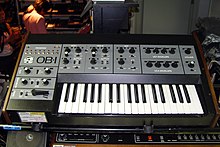The Oberheim OB-1 was a monophonic, programmable, analog synthesizer introduced by Oberheim Electronics in 1978. It originally sold for $1,895 and was the first analog synthesizer capable of storing patches. The design was a replacement for the previous generation of Oberheim SEM (Synthesizer Expansion Module) based instruments and intended to be used for live performance.[1][2]
| OB-1 | |
|---|---|

Oberheim OB-1
| |
| Manufacturer | Oberheim |
| Dates | 1978 |
| Price | US$1,895 |
| Technical specifications | |
| Polyphony | 1 voice |
| Timbrality | Monotimbral |
| Oscillator | 2 VCOs |
| LFO | 1 |
| Synthesis type | Analog Subtractive |
| Filter | 2 or 4 pole switchable VCF |
| Attenuator | 2 x ADSR; one for VCF, one for VCA |
| Aftertouch expression | No |
| Velocity expression | No |
| Storage memory | 8 patches |
| Effects | None |
| Input/output | |
| Keyboard | 37-key |
A slightly updated version, the Oberheim OB-1a, was introduced in 1979 that features the grey color scheme of its polyphonic sibling, the OB-X.[3]
The OB-1 is monophonic version of the Oberheim OB-X, with two VCOs and a Low Pass filter. It also contained an envelope control for both the filter and amplitude.[1]
Notable users of the OB-1 were the composer and musician Vince Clarke and the bands Tangerine Dream, Rush, and The Grid.[1] A 2014 feature on the French radio station France Inter claimed that the OB-1 had been used by the Star Wars sound engineer Ben Burtt to create the voice of R2-D2 and that the name of another Star Wars character, Obi-Wan Kenobi, derives from a transliteration of "OB-1".[4] However, Star Wars was first released in 1977, a year before the OB-1, and most sources credit the ARP 2600 synthesizer as being used to record R2-D2's voice.[5]